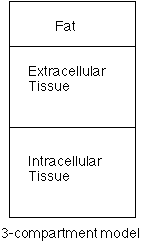Bioelectrical Impedance Analysis
BIA vs. Other Measures

|
Bioelectrical Impedance Analysis BIA vs. Other Measures |
 |
|
Measures adequately estimating body compartments are favored over total body measures of weight to support clinical decisions. While total body weight may work adequately in normal and healthy persons, it is subject to error in disease states. |
 |
|
|
Changes in intracellular and extracellular water compartments that occur with acute stress responses may overshadow efforts to determine the existence of wasting or even dehydration using body weight. As we will see, electrical measures used in tetrapolar BIA may be able to predict volumes of body compartments and associated water levels to an adequate degree of precision and accuracy for the clinical setting.[33] [34] |
||
 |
Several body composition validation studies have been conducted using BIA and criterion methods.[35] [36] [37] [38] [39] Estimations of both fat[40] and lean tissues have been explored. Linear equations for use with BIA readings relate height to the BIA resistance (R) reading and have been used to estimate lean tissues and fat. Linear regression equations have been developed using both DXA and hydrostatic weight as criterion method comparisons. |
|
|
From this information, the highly metabolic compartment of body cell mass has been assumed to be proportional to fat-free mass. |
||
 |
However, alterations in the extracellular fluids, often seen in acute and chronic diseases, may change the proportional relationship of BCM and FFM. If the extracellular compartment can be accounted for, then BCM can be better estimated in acute and chronic disease.[41] Two-compartment (fat-free mass and fat) linear equations are based on the body’s resistance to electrical current (expressed as ohms). Examples are illustrated in the following equations (Figure 2). |
|
Figure 2. Examples of Two-compartment Equations to Estimate Fat-Free Mass and Fat Mass by BIA[42] [43]
|
Children 10-19 years old |
FFM (kg) = [0.61(H2)/R] + 0.25(W) +1.31 |
|
Women 18-35 years old |
FFM (kg) = [0.666(H2)/R] + 0.164(W) + 0.217(Xc) – 8.78 |
|
Women 36-70 years old |
FFM (kg) = [0.475(H2)/R] + 0.295(W) + 5.49 |
|
Men |
FFM (kg) = [0.485(H2)/R] + 0.338(W) + 5.32 |
|
Specific populations may present limitations to the use of a single equation.[44] [45] [46] Linear equations assume that the hydration factor of FFM is constant and not different in the obese state. However, water distribution and body geometry is altered in the obese state causing electrical properties to vary from the assumptions made for normal, healthy populations. |
|
|
|
The hydration of FFM may be greater than 73% in obese patients, leading to an underestimation of fat. Also, changing patterns of fat seen in obesity (more pronounced in trunk regions) can alter the usefulness of the reading.43 Because impedance is proportional to the length and inversely proportional to diameter of the measured area, the trunk (shorter and wider than the limbs) contributes little to the reading. |
In addition, it has been suggested that the current standard frequency of 50 kHz may not fully penetrate the cell membrane and as such, may be most accurate to determining extracellular components than BCM.[47] Resistance to electrical charge is greater in intracellular spaces because of the resistance in cell membranes and differences in electrolyte concentrations between intracellular and extracellular contents. This high resistance of intracellular fluid may result in an overestimation of FFM in severely obese subjects.
Limitations of BIA testing have been assessed.
Alterations in cell conductance may not occur in the first few days of weight
loss. Short periods of fasting (up to 24 hours) may have little effect on
resistance readings, possibly due to the inability to measure ICW that is bound
to glycogen and lost during short fasting periods. Accuracy of measures in
non-fasting states has been tested.[48]
Additional items that appear to have limited to no effect on BIA readings
include time of day, interval since eating or drinking, oral contraceptive use,
and menstrual cycle.[49]
Predicted changes in the extracellular compartment of dialysis patients may be
larger than actual weight loss during dialysis because of a large increase in
impedance. Day to day changes in readings (10-15 ohms impedance) may equate to
1.5-2.0 kg of total body water or upwards of 2-3 kg of FFM, making smaller
changes difficult to evaluate using linear equations with BIA.
Because of many of the limitations in the use of BIA with other than physically normal, healthy populations, an exploration into the use of exponential equations using parallel reactance measures has been made. While resistance readings reflect the opposition to electrical current, reactance reflects the brief storage of voltage by cell membranes and tissue interfaces. Therefore, reactance is quite dependent on cell membrane health.[50] The reactance reading reflects about 3% of impedance,[51] and the use of both the resistance [R] and reactance [Xc] readings can help to predict the volume of FFM. It is the reactance reading that can differentiate between extracellular fluids and and total body water, an important feature to be able to isolate BCM. Exponential calculations allow the use of the reactance (Xc) reading from the BIA, is “tempered” by the resistance reading to better characterize individuals with altered cell membrane health and fluid shifts, and reflects a more complicated electrical properties of individuals. An example of reactance-based exponential equations is shown in Table 1.[52] To complete the estimation of BCM from TBK+ calculations, multiply the result by a factor of 0.833. Equations to calculate parallel reactance, parallel resistance, and phase angle are shown in Table 2.
Table 1. Reactance-Based Exponential Equations to Predict Body Composition.
| Sex | Total Body Water* | Fat-Free Mass* | Total Body Potassium* |
| Men | 0.58[(H1.62/Z0.70) x 1.0/1.35)] +0.32W – 3.66 | 0.50[(H1.48/Z0.55) x (1.0/1.21)] + 0.42W + 0.49 | 0.76[(H1.60/Xcp0.50) x 59.06] + 18.52W – 386.66 |
| Women | 0.76[(H1.99/Z0.58) x 1.0/18.91)] +0.14W – 0.86 | 0.88[(H1.97/Z0.49) x (1.0/25.22)] + 0.081W + 0.07 | 0.96[(H2.07/Xcp0.36) x 1.30] + 5.79W – 230.51 |
* in kilograms
Xcp = parallel reactance; Z =
impedance; H = height; W = weight
Table 2. Equation Calculations for Parallel Reactance (Xcp),
Parallel Resistance (Rp), Impedance (Z), and alpha-Phase Angle
Click on BIA Uses to go to the next section Back to Table of Contents
References[33] Hoffer EC, Meader CK, Simpson D. Whole body impedance and total body water. J Appl Physiol. 1969;27(4):531-534. [34] McDonald JJ, Chanduv B, Velarde G, Cama R, Diaz F, Carrillo L, Torre V, Watanabe J, Villarreal J, Ramirex-Ramos A, Mantle R, Gilman RH. Bioimpedance monitoring of rehydration in cholera. Lancet. 1993;341:1049-1051. [35] Lukaski HC, Bolonchuk WW, Hall CB, Siders WA. Validation of tetrapolar bioelectrical impedance method to assess human body composition. J Appl Physiol. 1986;60:1327-1332. [36] Jackson AS, Pollack ML, Graves J, Hahar MT. Reliability and validity of bioelectrical impedance in determining body composition. J Appl Physiol. 1988;64:529-524. [37] Roubenoff R. Applications of bioelectrical impedance analysis for body composition to epidemiologic studies. Am J Clin Nutr. 1996;64(Suppl):459S-462S. [38] Segal KR, Van Loan MD, Fitzgerald PI, Hodgdon JA, Van Itallie TB. Lean body mass estimation by bioelectrical impedance analysis: a four-site cross validation study. Am J Clin Nutr. 1988;47:7-14. [39] Sluys TEMS, van der Ende ME, Swart GR, van den Berg JWO, Wilson JHP. Body composition in patients with acquired immunodeficiency syndrome: a validation study of bioelectric impedance analysis. J Parenteral Enteral Nutr. 1993;17(5):404-406. [40] Abu Khaled M, McCutcheon MJ, Reddy S, Pearman PL, Hunder GR, Weinsier RL. Electrical impedance in assessing human body composition: the BIA method. Am J Clin Nutr.1988;47(5):789-792. [41] Kotler DP, Rosenbaum K, Allison DB, Wang J, Pierson RN. Validation of bioimpedance analysis as a measure of change in body cell mass as estimated by whole-body counting of potassium in adults. J Parenteral Enteral Nutr. 1999;23(6):345-349. [42] Houtkooper LB, Going SB, Lohman TG, Roche AF, Van Loan M. Bioelectrical impedance estimation of fat-free body mass in children and youth: a cross validation study. J Appl Physiol. 1992;72:366-373. [43] Lukaski HC. Biological indexes considered in the derivation of the bioelectrical impedance analysis. Am J Clin Nutr. 1996;64(Suppl):397S-404S. [44] Rising R, Swinburn B, Larson K, Ravussin E. Body composition in Pima Indians: validation of bioelectrical impedance. Am J Clin Nutr. 1991;53:594-598. [45] Baumgartner RN, Heymsfield SB, Lichtman S, Wang J, Pierson RN. Body composition in elderly people: effect of criterion estimates on predictive equations. Am J Clin Nutr. 1991;53:1345-1353. [46] Simons JP, Schols AM, Westerterp KR, Ten Velde GP, Wouters EF. The use of bioelectrical impedance analysis to predict total body water in patients with cancer cachexia. Am J clin Nutr. 1995;61:741-745. [47] Deurenberg P. Limitations ofr the bioelectrical impedance method for the assessment of body fat in severe obesity. Am J Clin Nutr. 1996;64(Suppl):449S-452S. [48] Hayes CR, Ropka ME, Sebring NG, Anderson RE. Recent food intake did not influence precision of body composition estimates by bioelectrical impedance analysis in men with HIV infection. J Amer Diet Assoc. 1996;96(4):386-388. [49] Chumlea WC, Roche AF, Guo S, Woynarowska B. The influences of physiologic variables and oral contraceptives on bioelectric impedance. Hum Biol. 1987;59:257-269. [50] Chumlea WC, Guo SS, Cockram DB, Siervogel RM. Mechanical and physiologic modifiers and bioelectrical impedance spectrum determinants of body composition. Am J Clin Nutr. 1996;64(Suppl):413S-422S. [51] Kuczmarski RJ. Bioelectrical impedance analysis measurements as part of a national survey. Am J Clin Nutr. 1996;64(Suppl):453S-458S. [52] Kotler DP, Burastero S, Wang J. Pierson RN. Prediction of body cell mass, fat-free mass, and total body water with bioelectrical impedance analysis: effects of race, sex, and disease. Am J Clin Nutr. 1996;64(Suppl):489S-497S. [53] Earthman CP, Matthie JR, Reid PM, Harper IT, Ravussin E, Howell WH. A comparison of bioimpedance methods for detection of body cell mass change in HIV infection. J Appl Physiol. 2000;88:944-956. [54] Ott M, Fischer H, Polat H, Helm EB, Frenz M, Caspary WF, Lembcke B. Bioelectrical impedance analysis as a predictor of survival in patients with human immunodeficiency virus infection. J Acquir Immune Def Syndr Hum Retrovirol. 1995;9(1):20-25.
|
|||||||||||||||||
Copyright © 2001 Hi-R-Ed.org. All courses posted on this site are the property of Hi-R-Ed.org unless otherwise stated. Courses may not be copied or transferred in electronic, printed, or other forms or modified for any purpose without explicit written consent of Hi-R-Ed.org or the copyright owner.If you are having problems with this website, please contact the webmaster. |